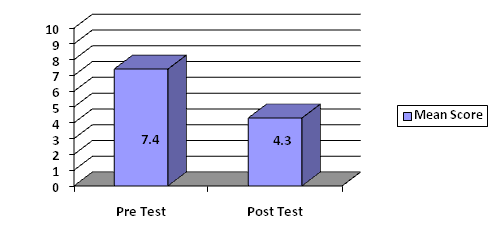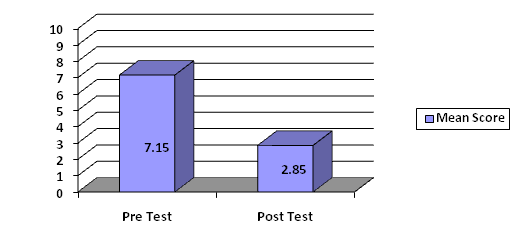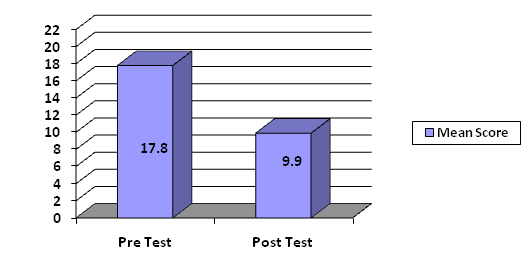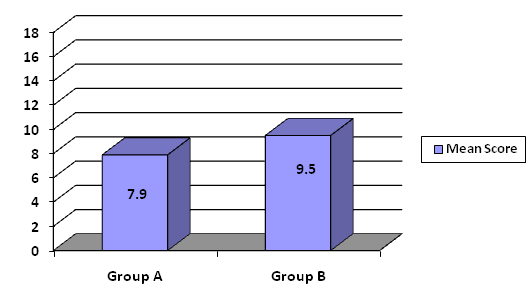MOJ
eISSN: 2374-6939


Research Article Volume 5 Issue 2
Department Physiotherapy, RVS College of Physiotherapy, India
Correspondence: Bhojan Kannabiran, Department Physiotherapy, RVS College of Physiotherapy, India, Tel 94879 68169, Fax 98941 51846
Received: April 15, 2016 | Published: June 27, 2016
Citation: Shaju F, Bhojan K (2016) A Comparative Study between Combinations of Ultrasound Therapy with Active Chin Tuck Exercise and UltrasoundTherapy with Sub Occipital Muscle Release in the Management of Non-Specific Neck Pain due to Sub Occipital Muscle Tightness among Computer Professionals. MOJ Orthop Rheumatol. 5(2): 00173. DOI: 10.15406/mojor.2016.05.00173
Neck pain is more common in people who spend most of their day working at a desk, in front of the computer with a ‘bent-forward’ posture or ‘forward head carriage’ posture. Non-Specific Neck Pain is most often caused by continuous forward head carrying posture leading to sub-occipital muscle tightness, decreased cervical mobility and obliterated cervical spine curvature. Forward head posture is commonly adopted by visual display terminal [VDT] workers involving a combination of lower cervical flexion and upper cervical extension. The rotatory motion of C1 and C2 is coupled to a vertical translation of the same two vertebrae. The head is supported by the lower neck and upper back, and it is these areas that commonly cause neck pain. The first three joints in the neck allow for most movement of the neck and head. The lower joints in the neck and those of the upper back create a supportive structure for the head to sit on. If this support system is affected, then the muscles in the area will become tight, causing neck pain.
A constant forward head posture reduces the average length of the rectus capitis posterior minor, the superior oblique, rectus capitis posterior major and inferior oblique muscles. It contributes to the development of chronic neck pain. Forward head posture is the anterior positioning of the cervical spine. In this position, head is slightly leaning forward which causes strain in cervical joints and muscles. There will be flexion in lower cervical region and extension in upper cervical region.
Question: To determine the efficacy of physiotherapeutic techniques in the treatment of Non-Specific Neck Pain due to Sub-occipital muscle tightness among computer professionals. To systematically compare the efficacy of Active Chin Tucking Exercises and sub occipital muscle release in the treatment of Non-Specific Neck Pain due to Sub-occipital muscle tightness among computer professionals.
Design: Comparative Study design
Methodology: It is a pre and post-test Experimental study, 20 computer professionals aged between 22 and 30 years who fulfilled inclusion criteria were randomly selected and assigned in to two groups of 10 subjects each. Group A was assigned for Ultrasound Therapy with Active Chin Tucking Exercises and Group B for Ultrasound Therapy with Sub Occipital Muscle release Technique. The study was conducted for a period of 7 days. Pain and neck function were measured before and after intervention by Visual Analog Scale and Copenhagen Neck Function Disability Scale respectively. The data collected from 20 subjects were evaluated statistically. Descriptive analytical study was done by using Paired’ test and Unpaired’ test.
Conclusion: It is concluded that there is reduction of pain & there is improvement in Neck function among computer professionals treated with Ultrasound Therapy and Active Chin Tuck Exercise for their neck pain & also in group treated with Ultrasound Therapy and Sub Occipital Muscle Release Technique for their neck pain.
It is concluded that combination of Ultrasound Therapy with Active Chin Tuck Exercise training group showed statistically significant improvement & found superior in improving neck function, whereas Ultrasound Therapy with Sub Occipital Muscle Release Technique training group showed statistically significant reduction in pain.
Keywords: Sub-occipital muscle release, Active chin tuck, Ultrasound, Sub occipital tightness, Computer professionals, Neck pain
Neck pain (or cervicalgia) is a common problem, with sixty percent of the population suffering with it at some point in their lives. Neck pain, although felt in the neck, can be caused by many other spinal problems. Neck pain may arise due to muscular tightness in both the neck and upper back, and pinching of the nerves emanating from the cervical spine. Non-Specific Neck Pain is the most common one. This is also known as ‘simple’ or “Mechanical’ neck pain. The causes may be minor strains and sprains to muscles or ligaments in the neck. Bad posture seems to be the major contributing factor in many cases. Neck pain can be caused due to many other physical and emotional health problems as well.
Neck pain is more common in people who spend most of their day working at a desk, in front of the computer with a ‘bent-forward’ posture or ‘forward head carriage’ posture. Non-Specific Neck Pain is most often caused by continuous forward head carrying posture leading to sub-occipital muscle tightness, decreased cervical mobility and obliterated cervical spine curvature. Forward head posture is commonly adopted by visual display terminal [VDT] workers involving a combination of lower cervical flexion and upper cervical extension. The important causes of forward head posture are improperly placed computer screen, looking down while typing or reading, sitting improperly with shoulders rounded and back hunched, slouched postures or end result of faulty pelvic and lumbar spine posture.
In upper cervical spine, flexion and extension both occur at the atlanto-axial region and atlanto-occipital region. The atlanto-occipital region has greater range of motion compared to atlanto-axial region. Flexion in occiput on the atlas is limited by bony contact between anterior rim of foramen magnum and superior surface of dens. The extension is limited by connective tissue restraints of the tectorial and atlanto-occipital membrane. The centre of rotation between C1and C2 falls in the region of dens. The dens closely nestled within the anterior arch of the atlas and surrounded by transverse ligament provide stability and checks the excessive flexion and extension movement. Few degrees of rotation also occur between occiput and atlas. The shape of bony articulations and a lar ligament provide rotation and prevents excessive rotation. The inferior articular process of the atlas and superior articular surface of the axis are flat to convex. The articular surface provides opportunity for rotatory motion located in the dens. The rotatory motion of C1and C2 is coupled to a vertical translation of the same two vertebrae. The head is supported by the lower neck and upper back, and it is these areas that commonly cause neck pain. The first three joints in the neck allow for most movement of the neck and head. The lower joints in the neck and those of the upper back create a supportive structure for the head to sit on. If this support system is affected, then the muscles in the area will become tight, causing neck pain.
Various structures involved in transmitting pain in the cervical spine include Facet joints, Inter-vertebral discs, Nerve roots, Ligaments, Fascia, and Muscles. In pathomechanics of upper cervical spine musculature, the rectus capitis posterior minor, the superior oblique, rectus capitis posterior major and inferior oblique muscles are innervated by the dorsal ramus of C1 (sub-occipital nerve) which exits from sub-occipital triangle superior to the arch of atlas. It is primarily a motor nerve but can have cutaneous branch that may result in pain if stretched or tapped. The sub-occipital muscles are deep and difficult to palpate. Several layers of large muscles and dense fascia are interposed between skin and these muscle groups. The location of the symptoms is usually bilateral; pain begins in the neck and spreads to sub-occipital region (area just below the posterior hair line). Tenderness will be present in neck extensors and sub-occipital muscles, neck stiffness, and restriction of neck movements and is diagnosed by mobility test and palpation of the upper cervical spine region for tenderness. A constant forward head posture reduces the average length of the rectus capitis posterior minor, the superior oblique, rectus capitis posterior major and inferior oblique muscles. It contributes to the development of chronic neck pain. Pain associated with muscle tightness in this area is due to the result of postural problems. The patient with a marked forward head and kyphotic upper thoracic region has a compensatory hyper extension of cervical spine and head. This position leads to tightening and subsequent shortening of the sub-occipital muscles and stretch weakness of anterior neck muscles. The mechanism of pain would be an abnormally large compression force on the articular facet due to altered and sustained pull of the shortened muscles.1
Forward head posture is the anterior positioning of the cervical spine. In this position, head is slightly leaning forward which causes strain in cervical joints and muscles. There will be flexion in lower cervical region and extension in upper cervical region. It is a long process brought about by constant and repetitive motion, where the head is leaning to the front. For every inch the head moves forward, it gains 10 pounds in weight as far as the muscles in neck and upper back are concerned because they had to work that much harder to keep head from dropping into the chest.2
Management of Non-Specific Neck Pain due to Sub occipital Muscle tightness includes active chin tucking exercises, ultrasound therapy, stretching, and mobilization of upper cervical muscles. Postural training is commonly used to treat poor posture and cervical dysfunction and involves exercises that are performed repeatedly within pain free range to stretch tightened structures and strengthen weak muscles.
Ultrasound Therapy is a method of treating tissue beneath the skin’s surface using sound waves. A 1MHz ultrasound will penetrate about 4” below the skin. Both the thermal and Non-thermal effects of the ultrasound are used to treat protective muscle spasm and pain. The increase in tissue temperature due to the therapy reduces the muscle spasm which causes pain in the region. This also helps in increasing the extensibility of the tissues due to the reduction in spasm.
Stretching techniques are used to increase the extensibility of the muscle tendon unit and the peri-articular connective tissue. Stretching is used to increase the flexibility. Self-Stretching is also referred to as flexibility exercise or active stretching exercises.3
There are many treatment protocols in the management of the non-specific neck pain among computer professionals, but which of them are practically effective is not properly reported. The need of this study is to validate and compare the effectiveness of sub occipital muscle release and Active Chin Tucking Exercises as a useful intervention in the management of Non-Specific Neck Pain due to Sub-occipital muscle tightness among computer professionals. This study serves as an initial step in a research process that would explore new Manual Therapy Techniques as useful addition to other interventions.
To determine the efficacy of physiotherapeutic techniques in the treatment of Non-Specific Neck Pain due to Sub-occipital muscle tightness among computer professionals. To systematically compare the efficacy of Active Chin Tucking Exercises and sub occipital muscle release in the treatment of Non-Specific Neck Pain due to Sub-occipital muscle tightness among computer professionals.
The study will create a wide spread awareness on Non-Specific Neck Pain and its implications as a barrier to an individual in the day-to-day activities at home and at workplace as well. The study will create awareness of body posture, physical well-being, positive attitude and mental make-up of computer professionals in enhancing their life style. The study will create awareness among physiotherapists about the new treatment combinations and the different choices of interventions available in treating Non-Specific Neck Pain among computer professionals.
A comparative study between combinations of ultrasound therapy with active chin tucking exercise and ultrasound therapy with sub occipital muscle release in the management of non-specific neck pain due to sub occipital muscle tightness among computer professionals.
Computer professionals
A computer professional is a person working in the field of Computers. This includes computer programmers and software engineers, computer scientists, computer systems analyst, computer technicians, Data entry operators, Graphic Designers, etc.4
Non-Specific neck pain
It is an acute (sudden onset) bout of neck pain which in most cases is not due to a serious disease or neck problem, but most often due to minor sprains or bad posture and in few cases the exact cause for the pain is not clear.5
Ultrasound therapy
Ultrasound is a type of sound, and all types of sound consist of waves that transmit energy by alternating compressing and rarefying material. It is sound with frequency greater than 20 KHz. Therapeutic Ultrasound has a frequency between 0.7 and 3.3 MHz to maximise energy absorption at a depth of 2 to 5 cm of soft tissue.6
Sub occipital muscle tightness
The state of activity or tension of sub occipital muscle beyond that related to its physical properties, that is, its active resistance to stretch.7
Study design
Pre-test Post-test Experimental Design, comparative in nature.
Study setting
This study was conducted at RVS College of physiotherapy, Department of orthopedics and sports medicine.
Study duration
The study was conducted for a period of 7 days.
Selection of subjects
20 computer professionals aged between 22 and 30 years who fulfilled inclusion and exclusion criteria were selected by purposive sampling method and randomly assigned to two groups of 10 subjects each. Group A was assigned for Ultrasound Therapy with Active Chin Tucking Exercises and Group B for Ultrasound Therapy with Sub Occipital Muscle release Technique Figure 1.

Figure 1 Flow diagram.
Measurement tool
Criteria for selection of subjects
Inclusion criteria
Exclusion criteria
Variables
Independent variable
Dependent variable
Measurement procedure
Visual Analog scale: The Visual Analog scale is a measurement tool that measures a characteristic or attitude which ranges across a continuum of values and cannot easily be directly measured. Operationally VAS is a horizontal line, 10 cm in length, anchored by word descriptors at each end, as illustrated in Figure 2. the subject marks on the line a point that they feel represents their perception of their current state of pain. The VAS score is determined by measuring in millimeters from the left hand end of the line to the point that the subject marks.
Copenhagen Neck Function Disability Scale: The Copenhagen Neck Function Disability Scale is used to evaluate the disability experienced by patients with neck pain. The scores can be monitored over time to evaluate the disease course and response to any intervention. It is set of 15 questions which rates as 0, 1 and 2 based on their ability and disability. The disability index is the sum of all the scores, where the higher ratings imply greater disability.
Both Group A and Group B subjects were involved in pre-test and post-test assessment by Visual Analog Scale and Copenhagen Neck Function Disability Scale.
Treatment procedure
Volume of Training
Treatment procedure for group A
Ultrasound therapy
Active chin tuck exercises
Ultrasound therapy
Sub occipital muscle release technique
Data analysis and interpretation
The data collected from 20 subjects were evaluated statistically. Descriptive analytical study was done by using Paired‘t’ test and unpaired‘t’ test. Table 1 shows Mean value, Mean Difference, Standard Deviation and Paired‘t’ value between pre and post test scores of Pain among Group A (Figure 3). Table 2 shows Mean value, Mean Difference, Standard Deviation and Paired‘t’ value between pre and post test scores of Pain among Group B (Figure 4). Table 3 showing Mean value, Mean Difference, Standard Deviation, and Unpaired‘t’ Value scores between Group A and Group B (Figure 5). Table 4 Shows Mean value, Mean Difference, Standard Deviation and Paired‘t’ value between pre and post test scores of Neck Function among Group A (Figure 6). Table 5 showing Mean value, Mean Difference, Standard Deviation and Paired‘t’ value between pre and post test scores of Neck Function among Group B (Figure 7). Table 6 shows Mean value, Mean Difference, Standard Deviation, and Unpaired‘t’ Value scores between Group A and Group B (Figure 8).

Figure 3 Bar diagram showing the pre and posttest mean values of Pain on Visual Analog Scale among Group A.

Figure 4 Bar diagram showing the pre and post test mean values of Pain on Visual Analog Scale among Group B.

Figure 6 Bar diagram showing the pre and post test mean values of Neck Function on Copenhagen Neck Function Disability Scale among Group A.

Figure 7 Bar diagram showing the pre and post test mean values of Neck Function on Copenhagen Neck Function Disability Scale among Group B.

Figure 8 Bar diagram showing Mean values of Neck Function on Copenhagen Neck Function Disability Scale in Group A and Group B.
Measurement |
Mean |
Mean Difference |
Standard Deviation |
Paired ‘t’ Value 0.05 Level of Sig |
Pre-test |
7.4 |
3.1 |
0.27 |
36.28 |
Post-test |
4.3 |
Table 1 Pain in Group A
Table 2 Pain in Group B |
S.No |
Groups |
Improvement |
Standard Deviation |
Unpaired ‘T’ Test 0.05 Level of Sig |
Mean |
Mean Difference |
1.2 |
2.23 |
|
1 |
GROUP-A |
3.1 |
||
2 |
GROUP-B |
4.3 |
Table 3 Comparison of Pain between Group A and Group B
Group A was treated with Ultrasound Therapy with Active Chin Tucking Exercises and Group B was treated with Ultrasound Therapy with Sub Occipital Muscle Release technique.
Analysis of dependent variable neck pain in group A: The Calculated Paired‘t’ value is 36.28 at 0.05 level of significance and the Paired Table ‘t’ value is 1.83 at 0.05 level of significance. Hence, the calculated‘t’ value is greater than the Table‘t’ value.
Measurement |
Mean |
Mean difference |
Standard deviation |
Paired ‘t’ Value 0.05 Level of Sig |
Pretest |
17.8 |
7.9 |
1.23 |
20.29 |
post test |
9.9 |
Table 4 Neck Function in Group A
Measurement |
Mean |
Mean Difference |
Standard Deviation |
Paired ‘t’ Value 0.05 Level of Sig |
Pre test |
14.6 |
9.5 |
0.94 |
31.93 |
post test |
5.1 |
Table 5 Neck Function in Group B
Analysis of dependent variable neck pain in group B: The Calculated Paired‘t’ value is 59.08 at 0.05 level of significance and the Paired Table ‘t’ value is 1.83 at 0.05 level of significance. Hence, the calculated‘t’ value is greater than the Table‘t’ value.
Analysis of dependent variable neck pain between group A and group B: The calculated Unpaired ’t’ value is 2.23 at 0.05 level of significance and the Unpaired Table ‘t’ value is 1.73 at 0.05 level of significance. Hence, the calculated‘t’ value is greater than Table‘t’ value.
S.No |
Groups |
Improvement |
Standard Deviation |
Unpaired “T” Test 0.05 Level Of Sig |
|
1 |
GROUP-A |
Mean |
Mean Difference |
3.5 |
1 |
2 |
GROUP-B |
||||
Table 6 Comparison of Neck Function between Group A and Group B
Analysis of dependent variable neck pain in group A: The Calculated Paired‘t’ value is 20.29 at 0.05 level of significance and the Paired Table ‘t’ value is 1.83 at 0.05 level of significance. Hence, the calculated‘t’ value is greater than the Table‘t’ value.
Analysis of dependent variable neck function in group B: The Calculated Paired‘t’ value is 31.93 at 0.05 level of significance and the Paired Table ‘t’ value is 1.83 at 0.05 level of significance. Hence, the calculated‘t’ value is greater than the Table‘t’ value.
Analysis of dependent variable neck function between group A and group B: The calculated Unpaired ’t’ value is 1.0 at 0.05 level of significance and the Unpaired Table ‘t’ value is 1.73 at 0.05 level of significance. Hence, the calculated‘t’ value is lesser than Table‘t’ value.
Discussion on findings
Non-Specific Neck pain is common among computer professionals because of as their faulty forward head posture while working on computers, which in turn places constant extension of the upper cervical structures causing tightness of the soft tissues in that area.9 Studies of Jordan Miller et al.10 shows that mobilization, manipulation and soft tissue techniques decreases pain and improve satisfaction in neck pain patients. Ylinen J et al.11 concluded that stretching of Sub occipital muscle influenced pain when combined with other treatment techniques/ modalities in the management of neck pain in patients with cervicogenic headache. Hanten et al.12 stated that manual therapy with home program of active neck retraction (Chin Tucking) exercises in a series of progressions was successful in relieving cervicogenic headache and improving neck function. Moodley M,13 studied and concluded that ultrasound therapy is helpful in treating Mechanical Neck pain.
The purpose of this study is to validate and compare the effects of combination of Ultrasound Therapy with Active Chin Tucking Exercise and combination of Ultrasound therapy with Sub occipital Release Technique on Pain and Neck Function among computer professionals.
The results of the present study indicate that the combination of Ultrasound therapy with Active Chin Tucking Exercise reduces pain and improves neck function as well, thereby validating the study of Hanten et al.12 Whereas the combination of Ultrasound therapy with sub occipital Muscle Release technique reduces only pain and has no significant effect on the neck function among computer professionals having Non Specific Neck Pain, which is similar to the results in the study of Ylinen J et al.11
Summary
A Pre-test Post-test Experimental study was conducted to compare the effectiveness of Active Chin Tucking Exercises and Sub Occipital Muscle Release Technique in reducing pain and improving neck function among computer professionals having non-specific neck pain.
20 subjects with neck pain were included in this study by purposive sampling and randomly assigned to two groups A and B with each group consisting of 10 subjects.
Group A was treated with Ultrasound Therapy with Active Chin Tuck Exercises and Group B was treated with Ultrasound Therapy with Sub Occipital Muscle Release Technique. Pain and Neck Function were assessed before and after the intervention by Visual Analog scale and Copenhagen Neck Function Disability Scale respectively.
The statistical result shows that there is improvement in both the groups. But when comparing both it was found that Sub Occipital Muscle Release Technique is more effective than Active Chin Tuck Exercises
Conclusion
The study was conducted with a sample size of 20, the age group of the sample being 22 to 30 years with treatment duration of 6 days.
Future research can be conducted with a larger sample size, wider age group, different variables, more consistent outcome measures and different treatment durations.
None.
None.

©2016 Shaju, et al. This is an open access article distributed under the terms of the, which permits unrestricted use, distribution, and build upon your work non-commercially.